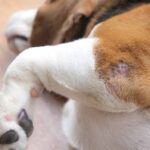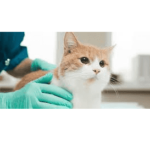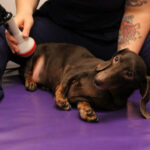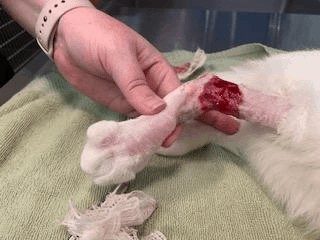
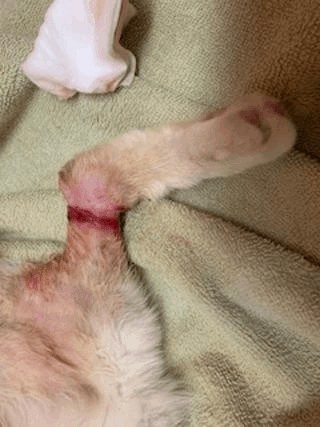
resolved
Animals, like people, at some point in their lives experience trauma. Often this manifests itself as wounds. With early intervention, most wounds, can heal.
This discussion will focus on the skin and the wounds experienced in the skin and underlying tissues.
The skin and its associated tissues exist in layers: the epidermis on the outside (layered in and of itself); the dermis below; the subcutis below that; and fat and muscle below that. When injuries to the skin and associated layers occur, different presentations are seen including clean cuts, punctures, scrapes, ulcerations and burns. These wounds can be sterile, unclean (relatively clean but not sterile), or even infected.
The Healing Process Starts as Soon as the Wound is Inflicted
There are four phases of wound healing: Inflammation, debridement, repair, and maturation.
Inflammation (Starts Immediately)
This is the first phase of healing and is all about controlling bleeding and activating the immune system. Without going into too much molecular detail, blood clots are formed and blood vessels constrict to reduce blood loss. This process recruits cells of the immune system that in essence “clean up” and help address contaminating bacteria and any dead tissue.
Debridement (Starts in a Few Hours)
Wound fluid, dead tissue, and immunologic cells form pus, which is designed to flow as a liquid from the wound and carry debris with it. The cells that were called to the wound in the inflammation phase are now actively working on consuming dead tissue and cleansing the area.
Repair (Starts in a Couple Of Days)
Collagen begins to fill in the wound to bind the torn tissues, a process that will take several weeks to complete. New blood vessels begin to grow into the area from the uninjured blood vessels nearby. The wound edge begins to produce granulation tissue, the moist pink tissue that will ultimately fill in the wound. The wound will shrink in a process called wound contraction so that new skin can form and cover it.
Maturation (Starts in 2-3 Weeks and can Take Months or Even Years)
Once plenty of collagen has been deposited, the final phase of scarring can form. The scar becomes stronger and stronger over time as new blood vessels and nerves grow in and the tissue reorganizes. The final result will never be as strong as un-injured tissue but should ultimately achieve approximately 80% of the original strength
Spay Incision
A spay incision is an example of a wound healing by primary intention.
Primary Intention
When the wound is a surgical incision with sutures in place, there is no area for the body to fill with granulation tissue. Instead, the wound margins are already held together and the two margins simply need to bond together. New skin begins to form across the margin within two days. The four stages of healing continue as above but go much faster (10-14 days total) because there is no gap in the tissue to fill in.
Healing occurs across the wound margin, not down its length, which means long incisions heal just as fast as short ones.
Secondary Intention
If the wound cannot be closed with sutures (it is too big, there is too much tension on the wound margins pulling them apart, the wound is too infected, etc.), then a process called second intention comes into play. This is the part of wound healing where granulation tissue must form to fill in the gap. Once the wound is filling with granulation tissue, contraction soon follows, which means the wound will be getting smaller and smaller. Eventually it can be allowed to simply close on its own or, when it is small enough, the margins can be trimmed and the wound surgically closed by primary intention for a smaller scar and better fur coverage. In the right circumstances, skin grafts either from the animal itself or fish skin grafts can be applied but only if there is a healthy granulation bed.
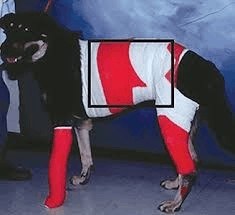
moist and clean. This dog is
having wounds addressed with
special bandaging
Granulation Tissue is Great!
It looks like it would be sore. Many people incorrectly feel granulation tissue is not supposed to be there when, in fact, it is a sign of a healthy healing wound.When a wound is cleansed of debris, scabs, or crusts (and often when a bandage is removed), granulation tissue is evident. Many people, especially those not familiar with wound management, find granulation to be disturbing: it is red or bright pink, moist, bleeds easily, and is often confused with underlying muscle.
Granulation tissue:
- Should be moist so as to allow better blood flow and a proper debridement phase.
- Bleeds easily as it is rich in blood vessels.
- Generally is not painful as nerves grow into granulation tissue late in the healing process.
How We Help
The body is pretty good at healing but there are some things that can go wrong as well as ways that we can facilitate the healing process.
- Deeper pus pockets must be drained. Eventually these will probably rupture out on their own (it can be a disaster if they rupture in instead of out), but often they will take a great deal of overlying tissue with them if left to their own devices. If the pus can be drained by lancing and flushing, this will usually prevent a large tissue slough if the abscess is allowed to rupture on its own. Sometimes in-dwelling drains must be placed surgically to assist in removing harmful fluids.
- The wound must be kept moist. This can be accomplished with bandages and/or ointments. A moist wound has better blood flow and can heal more effectively.
- Gross contamination should be cleaned up. Dirt, hair, pus and other bacteria-rich substances should be flushed from the wound. Antibiotics may be needed either orally, topically, or both to address infection.
- Resistant bacteria may be involved with the wound. A culture and sensitivity of a wound should be obtained early on to ensure your pet is on an appropriate antibiotic
- Dead tissue should be trimmed. If there is non-viable tissue in the wound, it should be removed so the body will not have to liquefy it. This can be done through surgery, through certain types of bandages or by topical applications depending on the type of wound.
- Wound-enhancing topical products can be applied. There are a number of topicals touted to reduce infection and/or enhance the formation of granulation tissue. It often seems like new products are available annually so we won’t review them but your veterinarian may select one to potentially assist the body’s wound healing efforts.
First Aid Tip: If your pet’s wound is fresh and your pet will allow it, try to wash out large debris particles with tap water (saline flush as used for eyes is even better as it is balanced for tissue exposure). Cover the wound with clean, dry bandage material, if possible. As soon as possible, see your veterinarian for professional wound care.
